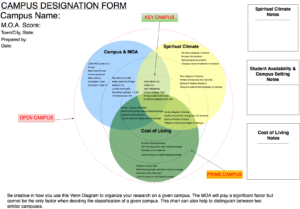Developing a pioneering strategy and a clear system for approving leaders is the critical step in preparing for growth within your district! Here you will find access to resources in developing these systems:
Strategic Plan must include…
1. Where to Pioneer next.
2. Consistent process to approve a pioneer (director).
3. Clear plan to training and coach the pioneering team.
Developing the answer to these questions are the very resources one will find on this site. The Pioneer Task Force has been developing resources and clarify strategies for the last 10 years in order to bring consistency in the growth of Chi Alpha. Click jump to Approval Process or Pioneering Boot Camps & Coaching
Where to pioneer next?
To answer where next, we must assess the current development of Chi Alpha in your state? Do you have a Chi Alpha ministry with a CMIT program? Does your state have a long running ministry that “defines” what a healthy XA program looks like?
We have observed three phases in developing a district Chi Alpha program:
Phase 1: Focus on a “Key” Campus
Focusing on an “early win” that will define in the minds of pastors and others leaders what a healthy XA program is. Planting on a campus that has fewer obstacles to building a dynamic ministry is crucial for an early win. Not all campuses give us the same chance for defining success and developing more XA leaders. What type of campus offers this? Across the US these campuses have been 4-year state schools under 20,000 students with strong freshman living on campus and lower academic riggers. We call these campuses “Key.” If your state has XA chapters but none of them host a CMIT program whose alumni enter the ministry vocationally, start here. Measure of Availability (MOA) is a tool used to identify which campuses maybe Key. (See below for more information on the MOA).
Phase 2: Building the Chi Alphas on “Prime” Campuses
Every state has a “flagship” campus(es), whether it be the largest school or the one with famous athletic program. It’s tempting to rush to this campus to plant a XA. It’s a great second target but not the first. Why? Generally it is harder to gain traction on these campuses. “Flagship” campuses have so much competing for students attention, demanding academics, “college life” and Frats or Sororities usually make these larger campuses a challenging target to develop a “model ministry.” When developing a district one needs to focus on early wins and developing laborers to form teams to reach the rest of the campuses. Flagship campuses historically have not produced sustained CMIT programs. This is why a Key campus is a critical step in developing a self sustaining strategy.
Many other campuses will fall in the Prime campus category; Ivy League, many private colleges, any campus over 30,000, HBCU or any other 4 year college that doesn’t score as high on the MOA.
Phase 3: Reach them all!
When a district is producing XA leaders through their own CMIT program, have multiple healthy XA chapters it will not be hard to see others wanting to join the student movement. These include the small private campuses and junior colleges.
The order in which we pioneer and target campuses is critical. As we’ve surveyed Chi Alpha’s strongest districts, we discovered they all had a “Key” campus that are feeder programs for the rest of the campuses across their state.
MEASURE OF AVAILABILITY (M.O.A.)
The research going into this correlation matrix was based on Chi Alpha’s historical success by looking specifically at what is common among the campuses that have the most CMIT’s each year secondly, the focus was on which campuses have the most alumni who complete a CMIT and make XA their career. The MOA score reflects the similarity of a given campus to the campuses like Central Arkansas, Sam Houston State, Western Washington and University of Louisiana – Lafayette, which currently have over 10+ CMIT’s annually.

The strategic plan for a district must include a focus on a campus which has the potential of equipping and releasing laborers!
There is so much more than identifying the M.O.A. of a campus to determine if it is Key, Prime or Open. One must evaluate the “spiritual climate” of a given campus and community. In addition, is the community affordable for a team of planters? After gathering the M.O.A. for each unchartered campus, use the Campus Designation Form as a tool to evaluate other factors that will help guide the prayerful process in identifying which should be your top priorities for pioneering.
Goto http://nwxa.org/leaders/MOA to run a MOA survey on a given campus. NOTE: Login and password is the same: “moa1survey”
Download a copy of “Campus Designation Form“
Having a strategic plan laid out helps guide the next question, who will lead the charge? A note of wisdom from experience – once someone has “asked” to pioneer a specific campus, it is hard to redirect them. Why not have a Holy Spirit inspired plan that we can use to recruit and guide leaders through.
Next step, Approval Process:
The purpose of these tools is help district leadership identify campus priorities prior to an individual seeking approval to pursue pioneering a campus. This will help clarify who is qualified to pioneer a Key, Prime or Open campus prior to anyone being considered. This will also help guide the order of which campuses are promoted for recruitment. If you have any further questions, be sure to contact us to guide you in the process.
[button target=”blank” link=”http://xanetwork.org/approval/” size=”small” align=”left”]Approval Process[/button][margin30]
Click to jump to Training & Coaching